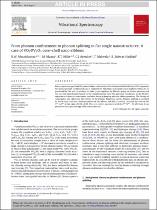 ResearchSpace
ResearchSpace
From phonon confinement to phonon splitting in flat single nanostructures: A case of VO2@V2O5 core–shell nano-ribbons
JavaScript is disabled for your browser. Some features of this site may not work without it.
- ResearchSpace
- →
- Research Publications/Outputs
- →
- Journal Articles
- →
- View Item
| dc.contributor.author |
Mwakikunga, Bonex W

|
|
| dc.contributor.author |
Maaza, M

|
|
| dc.contributor.author |
Hillie, KT

|
|
| dc.contributor.author |
Arendse, CJ

|
|
| dc.contributor.author |
Malwela, T

|
|
| dc.contributor.author |
Sideras-Haddadf, E

|
|
| dc.date.accessioned | 2012-06-14T11:49:47Z | |
| dc.date.available | 2012-06-14T11:49:47Z | |
| dc.date.issued | 2012-07 | |
| dc.identifier.citation | Mwakikunga, BW, Maaza, M, Hillie, KT, Arendse, CJ, Malwela, T and Sideras-Haddadf, E. 2012. From phonon confinement to phonon splitting in flat single nanostructures: A case of VO2@V2O5 core–shell nano-ribbons. Vibrational Spectroscopy, vol. 61, pp 105-111 | en_US |
| dc.identifier.issn | 0924-2031 | |
| dc.identifier.uri | http://www.sciencedirect.com/science/article/pii/S0924203112000513 | |
| dc.identifier.uri | http://hdl.handle.net/10204/5910 | |
| dc.identifier.uri | https://doi.org/10.1016/j.vibspec.2012.02.007 | |
| dc.description | Copyright: 2012 Elsevier. This is the post-print version of the work. The definitive version is published in Vibrational Spectroscopy, vol. 61, pp 105-111 | en_US |
| dc.description.abstract | Raman spectroscopy of the VOx nano-ribbons is discussed in the framework of the Richter (1981) equation for optical phononconfinement (a) as modified for thin films by Fauchet and Campbell (1986), (b) as presented by Kim and co-workers for slabs, (c) as explained by Eklund's group for surface phonons and (d) our own modification based on the transformation from the spherical coordinates in the Richter equation to Cartesian coordinates; the latter being in keeping with the ribbon geometry. The change of coordinates also influences the profiles of the phonon dispersion curves. Phononsplitting is ascribed to the bi-layer and core–shell geometries of the ribbons and this is used to calculate the ratio of the V5+ to V4+ to the value of 0.54 ± 0.10. This is in perfect agreement with the V5+/V4+ 54.60% from X-ray photo-electron spectroscopy (XPS) measurements. | en_US |
| dc.language.iso | en | en_US |
| dc.publisher | Elsevier | en_US |
| dc.relation.ispartofseries | Workflow;8992 | |
| dc.subject | Vanadium oxides | en_US |
| dc.subject | Phonon confinement | en_US |
| dc.subject | Phonon splitting | en_US |
| dc.subject | Cations | en_US |
| dc.subject | Stoichiometry | en_US |
| dc.title | From phonon confinement to phonon splitting in flat single nanostructures: A case of VO2@V2O5 core–shell nano-ribbons | en_US |
| dc.type | Article | en_US |
| dc.identifier.apacitation | Mwakikunga, B. W., Maaza, M., Hillie, K., Arendse, C., Malwela, T., & Sideras-Haddadf, E. (2012). From phonon confinement to phonon splitting in flat single nanostructures: A case of VO2@V2O5 core–shell nano-ribbons. http://hdl.handle.net/10204/5910 | en_ZA |
| dc.identifier.chicagocitation | Mwakikunga, Bonex W, M Maaza, KT Hillie, CJ Arendse, T Malwela, and E Sideras-Haddadf "From phonon confinement to phonon splitting in flat single nanostructures: A case of VO2@V2O5 core–shell nano-ribbons." (2012) http://hdl.handle.net/10204/5910 | en_ZA |
| dc.identifier.vancouvercitation | Mwakikunga BW, Maaza M, Hillie K, Arendse C, Malwela T, Sideras-Haddadf E. From phonon confinement to phonon splitting in flat single nanostructures: A case of VO2@V2O5 core–shell nano-ribbons. 2012; http://hdl.handle.net/10204/5910. | en_ZA |
| dc.identifier.ris | TY - Article AU - Mwakikunga, Bonex W AU - Maaza, M AU - Hillie, KT AU - Arendse, CJ AU - Malwela, T AU - Sideras-Haddadf, E AB - Raman spectroscopy of the VOx nano-ribbons is discussed in the framework of the Richter (1981) equation for optical phononconfinement (a) as modified for thin films by Fauchet and Campbell (1986), (b) as presented by Kim and co-workers for slabs, (c) as explained by Eklund's group for surface phonons and (d) our own modification based on the transformation from the spherical coordinates in the Richter equation to Cartesian coordinates; the latter being in keeping with the ribbon geometry. The change of coordinates also influences the profiles of the phonon dispersion curves. Phononsplitting is ascribed to the bi-layer and core–shell geometries of the ribbons and this is used to calculate the ratio of the V5+ to V4+ to the value of 0.54 ± 0.10. This is in perfect agreement with the V5+/V4+ 54.60% from X-ray photo-electron spectroscopy (XPS) measurements. DA - 2012-07 DB - ResearchSpace DP - CSIR KW - Vanadium oxides KW - Phonon confinement KW - Phonon splitting KW - Cations KW - Stoichiometry LK - https://researchspace.csir.co.za PY - 2012 SM - 0924-2031 T1 - From phonon confinement to phonon splitting in flat single nanostructures: A case of VO2@V2O5 core–shell nano-ribbons TI - From phonon confinement to phonon splitting in flat single nanostructures: A case of VO2@V2O5 core–shell nano-ribbons UR - http://hdl.handle.net/10204/5910 ER - | en_ZA |





